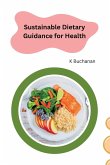Food systems encompass various stages, including food production, processing, packaging, storage, transportation, distribution, advertising, consumption, and food waste (1). Unfortunately, our current global food systems have a detrimental impact on the environment and contribute to greenhouse gas emissions (GHGEs) (1). In fact, these systems account for approximately 19% to 29% of GHGEs worldwide (1). GHGEs are a significant contributor to global warming, with temperatures rising by approximately 3% each year (1). This poses a serious problem, as global food temperatures have already increased by 2 °C since the 1750s (2). Moreover, food systems utilize around 86% of the world's fresh water (3) and are responsible for the loss of natural habitats, forests, and biodiversity (1, 4, 5). To address this issue, substantial reductions in GHGEs are necessary at various stages of the food chain (2). Furthermore, our dietary behaviors exert a significant impact on both our health and the environment. Unhealthy dietary habits, such as excessive consumption of ultra-processed foods, animal-derived products (particularly red meat), sugar-sweetened beverages, and insufficient intake of fruits, vegetables, and legumes, burden individuals' health and strain our healthcare systems (6). These unhealthy dietary patterns are linked to the development of chronic diet-related diseases, including obesity, type 2 diabetes, cardiovascular disease, and certain cancers (7). Reducing the consumption of animal-derived foods can lead to a substantial decrease in GHGEs and mitigate the risk of cardiovascular diseases (6). Conversely, increased consumption of plant-based foods, such as grains, legumes, nuts, fruits, and vegetables, offers health and environmental benefits (8). Manufacturing animal-derived products is estimated to contribute to 50% of the total GHGEs associated with food production (2). For instance, the production of one kilogram of beef releases approximately 60 kilograms of GHGEs, while peas only emit 1 kilogram per kilogram (9). Animal feed production plays a crucial role in GHGEs due to the utilization of fossil fuels in farming, transportation, and feed processes, as well as the loss of natural areas for grazing or feed farming (1). Additionally, ruminant animals (such as cows, goats, and sheep) require more feed per kilogram of meat compared to monogastric animals (like pigs and rabbits), resulting in higher GHGEs from ruminant meat production (1, 9). For example, lamb emits around 20 kilograms of CO2-equivalent per kilogram, while poultry and pork emit 6 and 7 kilograms respectively. Although lower than lamb emissions, it still exceeds the majority of plant-based food emissions (9). Red meat consumption exceeds recommended levels in many developed countries, including Australia (10, 11). Therefore, reducing red meat intake emerges as one of the most significant strategies to mitigate health and environmental impacts. It is evident that population dietary behaviors and environmental sustainability are intertwined. The concept of "sustainable and healthy diets" has garnered increased attention in recent years, although its roots trace back to the 1920s when Gussow and Clancy highlighted the influence of food choices on the environment (8). Their guidelines encompassed reducing food waste, limiting animal-derived foods, and promoting local food consumption, echoing the principles we adhere to today (8). Numerous countries have developed dietary guidelines to guide individuals toward consuming diets that improve health and reduce the risk of non-communicable diseases (NCDs), such as the Australian Guide to Healthy Eating (AGHE) (12) and the Eatwell Guide in the United Kingdom (UK) (13). However, countries like Canada and Sweden have extended their dietary guidelines








